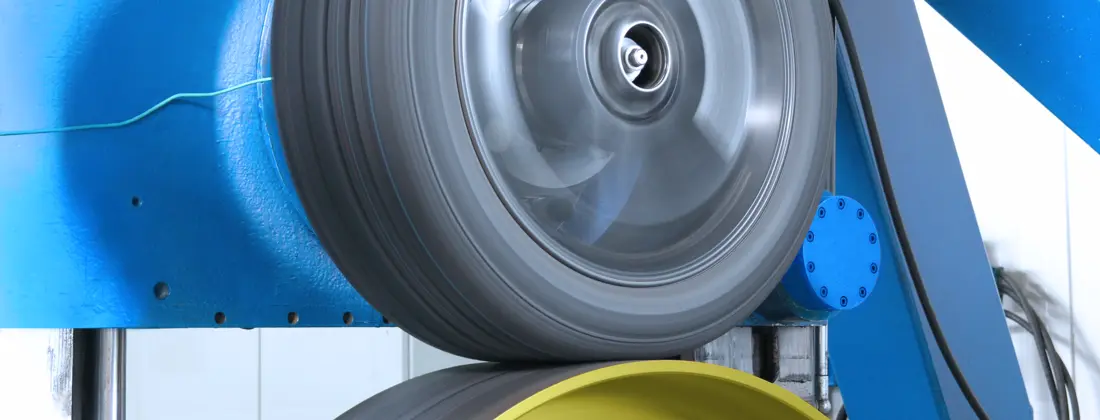EN 14243 Tyre Rolling Resistance Test
The EN 14243 standard is a European regulation that provides the requirements for determining the rolling resistance of tyres. This test is crucial in ensuring that tyres meet regulatory standards and contribute to fuel efficiency, thereby reducing environmental impact.
Rolling resistance refers to the force required to move a tyre at a given speed. Lower rolling resistance equates to better fuel efficiency as less energy is lost to friction. The EN 14243 test measures this by determining how much energy it takes for a tyre to roll over a specific distance under controlled conditions. This is achieved through the use of specialized equipment such as a rolling resistance tester, which simulates real-world driving conditions.
The test involves mounting tyres on a rotating drum that replicates road surfaces and applying a standard load to simulate actual vehicle weight. The speed at which the tyre rolls over the drum is controlled according to the specified parameters in EN 14243. Sensors measure the force required for the tyre to roll, thereby providing an accurate measurement of rolling resistance.
For tyres intended for passenger vehicles, the rolling resistance test is conducted under conditions that mimic typical driving scenarios. This includes testing at various speeds and temperatures to ensure the tyre performs consistently across different environmental conditions. The test results are then used to classify tyres into categories based on their rolling resistance coefficient (CRC), which ranges from A to G, with lower values indicating better fuel efficiency.
For commercial vehicle tyres, the EN 14243 test may involve more stringent criteria due to the higher loads and speeds they encounter. The test setup includes a larger drum capable of simulating these conditions accurately. Additionally, the rolling resistance coefficient is used as a key metric in determining fuel savings for commercial fleets.
The importance of this test cannot be overstated, especially considering the global push towards sustainable transportation practices. By adhering to EN 14243 standards, tyre manufacturers can ensure their products meet stringent regulatory requirements and contribute positively to environmental conservation efforts.
- Passenger vehicle tyres: A to G classification based on CRC
- Commercial vehicle tyres: Higher load and speed simulation for accuracy
- Sustainability focus: Lower rolling resistance coefficients translate to better fuel efficiency
The EN 14243 test is a critical component in the tyre manufacturing process, providing manufacturers with detailed insights into how their products perform under various conditions. This information is invaluable for R&D teams looking to innovate and improve tyre design.
Industry Applications
The EN 14243 rolling resistance test has wide-ranging applications across the automotive industry, particularly in the development and certification of tyres. Quality managers and compliance officers rely on this test to ensure that tyre specifications meet or exceed regulatory standards.
R&D engineers use the results from the EN 14243 test to refine tyre designs, focusing on reducing rolling resistance while maintaining other essential performance characteristics such as traction and durability. This iterative process is crucial for developing tyres that not only comply with regulations but also offer superior performance in real-world driving conditions.
Procurement teams benefit from the EN 14243 test by gaining transparency into the quality and performance of tyre suppliers. By specifying the EN 14243 standard as a requirement, procurement managers can ensure that only high-quality tyres are used in their manufacturing processes.
The test also plays a vital role in fleet management for commercial vehicles. By selecting tyres with lower rolling resistance coefficients, fleet operators can achieve significant fuel savings and reduce operational costs. This is particularly important given the increasing cost of diesel and the need to minimize environmental impact.
Eurolab Advantages
At Eurolab, we bring extensive expertise in tyre testing, ensuring that our clients receive accurate and reliable results for their EN 14243 tests. Our state-of-the-art facilities are equipped with the latest technology to simulate real-world driving conditions accurately.
We employ highly skilled professionals who are well-versed in the nuances of tyre testing according to the EN 14243 standard. This ensures that our clients receive not just test results but also comprehensive analysis and recommendations for improving their products or processes.
Our commitment to quality is reflected in our adherence to international standards, including ISO/IEC 17025 accreditation for our laboratories. This certification guarantees that our testing methods are robust and reliable, providing clients with confidence in the results they receive.
We offer a range of additional services beyond the EN 14243 test, such as tyre durability tests and traction performance evaluations. These complementary services allow us to provide a comprehensive approach to tyre development and certification.
International Acceptance and Recognition
The EN 14243 standard is widely recognized across Europe for its accuracy and reliability in measuring tyre rolling resistance. It has been adopted by many countries outside of the European Union, including Australia, New Zealand, and parts of North America.
- Australia: The Australian Design Rules (ADR) incorporate EN 14243
- New Zealand: Standards New Zealand has recognized EN 14243 for tyre testing
- North America: While not universally adopted, some states and provinces have begun to consider its implementation
The standard's acceptance is due to its rigorous methodology and consistent results across different laboratories. This ensures that regardless of where the tyres are tested, the rolling resistance values remain comparable.
The widespread adoption of EN 14243 contributes to a more harmonized approach to tyre testing globally, facilitating trade and ensuring that consumers can trust the performance claims made by tyre manufacturers.





